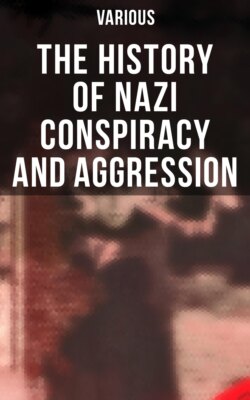Читать книгу The History of Nazi Conspiracy and Aggression - Various - Страница 135
На сайте Литреса книга снята с продажи.
Оглавление“Your Eminence knows very well the greatest difficulty in the way of opening negotiations comes from the overruling authority which the “National Socialist Party Chancery” (Kanzlei der National-Sozialistischen Partei, known as the Partei-Kanzlei) exercises in relation to the Chancery of the Reich (Reichskanzlei) and to the single Reich Ministries. This ‘Parteikanzlei’ directs the course to be followed by the State, whereas the Ministries and the Chancery of the Reich are obliged and compelled to adjust their decrees to these directions. Besides, there is the fact that the “Supreme Office for the Security of the Reich” called the ‘Reichssicherheitshauptamt’ enjoys an authority which precludes all legal action and all appeals. Under it are the ‘Secret Offices for Public Security’ called ‘Geheime Staatspolizei’ (a title shortened usually to Gestapo) of which there is one for each Province. Against the decrees of this Central Office (Reichssicherheitshauptamt) and of the Secret Offices (Geheime Staatspolizei) there is no appeal through the Courts, and no complaint made to the Ministries has any effect. Not infrequently the Councillors of the Ministries suggest that they have not been able to do as they would wish to, because of the opposition of these Party offices. As far as the executive power is concerned, the organization called the SS, that is Schutzstaffeln der Partei, is in practice supreme.
“This hastily sketched interrelation of authorities is the reason why many of the petitions and protests made by the Bishops to the Ministries have been foiled. Even if we present our complaints to the so-called Supreme Security Office, there is rarely any reply; and when there is, it is negative.
“On a number of very grave and fundamental issues we have also presented our complaints to the Supreme Leader of the Reich (Fuehrer). Either no answer is given, or it is apparently edited by the above-mentioned Party Chancery, which does not consider itself bound by the Concordat made with the Holy See.” (3266-PS)
The interchange of correspondence following the transmission of the above-described note of 2 March 1943 on the religious situation in the overrun Polish Provinces illustrates the same evasive tactics. (3269-PS)
In his Allocution to the Sacred College, on 2 June 1945, His Holiness Pope Pius XII recalled, by way of example, “some details from the abundant accounts which have reached us from priests and laymen who were interned in the concentration camp at Dachau”:
“In the forefront, for the number and harshness of the treatment meted out to them, are the Polish priests. From 1940 to 1945, 2,800 Polish ecclesiastics and religious were imprisoned in that camp; among them was the Auxiliary bishop of Wloclawek, who died there of typhus. In April last there were left only 816, all the others being dead except for two or three transferred to another camp. In the summer of 1942, 480 German-speaking ministers of religion were known to be gathered there; of these, 45 were Protestants, all the others Catholic priests. In spite of the continuous inflow of new internees, especially from some dioceses of Bavaria, Rhenania and Westphalia, their number, as a result of the high rate of mortality, at the beginning of this year, did not surpass 350. Nor should we pass over in silence those belonging to occupied territories, Holland, Belgium, France (among whom the Bishop of Clermont), Luxembourg, Slovenia, Italy. Many Of those priests and laymen endured indescribable sufferings for their faith and for their vocation. In one case the hatred of the impious against Christ reached the point of parodying on the person of an interned priest, with barbed wire, the scourging and the crowning with thorns of our Redeemer.” (3268-PS)
Further revealing figures on the persecution of Polish priests are contained in the following extract from Charge No. 17 against Hans Frank, Governor-General of Poland, submitted by the Polish Government, entitled “Maltreatment and Persecution of the Catholic Clergy in the Western Provinces”:
“IV. GENERAL CONDITIONS AND RESULTS OF THE PERSECUTION
11. The general situation of the clergy in the Archdiocese of Poznan in the beginning of April 1940 is summarized in the following words of Cardinal Hlond’s second report:
‘5
priests shot
27
priests confined in harsh concentration camps at Stutthof and in other camps
190
priests in prison or in concentration camps at Bruczkow, Chludowo, Goruszki, Kazimierz, Biskupi, Lad, Lubin and Puszczykowo,
35
priests expelled into the Government General,
11
priests seriously ill in consequence of ill-treatment,
122
parishes entirely left without priests.’
12. In the diocese of Chelmno, where about 650 priests were installed before the war only 3% were allowed to stay, the 97% of them were imprisoned, executed or put into concentration camps.
13. By January 1941 about 7000 priests were killed, 3000 were in prison or concentration camps.” (3279-PS)
The Allocution of Pope Pius XII on 2 June 1945 described National Socialism as “the arrogant apostasy from Jesus Christ, the denial of His doctrine and of His work of redemption, the cult of violence, the idolatry of race and blood, the overthrow of human liberty and dignity.” It summarized the attacks of “National Socialism” on the Catholic Church in these terms:
“The struggle against the Church did, in fact, become even more bitter: there was the dissolution of Catholic organizations; the gradual suppression of the flourishing Catholic schools, both public and private; the enforced weaning of youth from family and Church; the pressure brought to bear on the conscience of citizens, and especially of civil servants; the systematic defamation, by means of a clever, closely-organized propaganda, of the Church, the clergy, the faithful, the Church’s institutions, teaching and history; the closing, dissolution, confiscation of religious houses and other ecclesiastical institutions; the complete suppression of the Catholic press and publishing houses.” (3268-PS)
